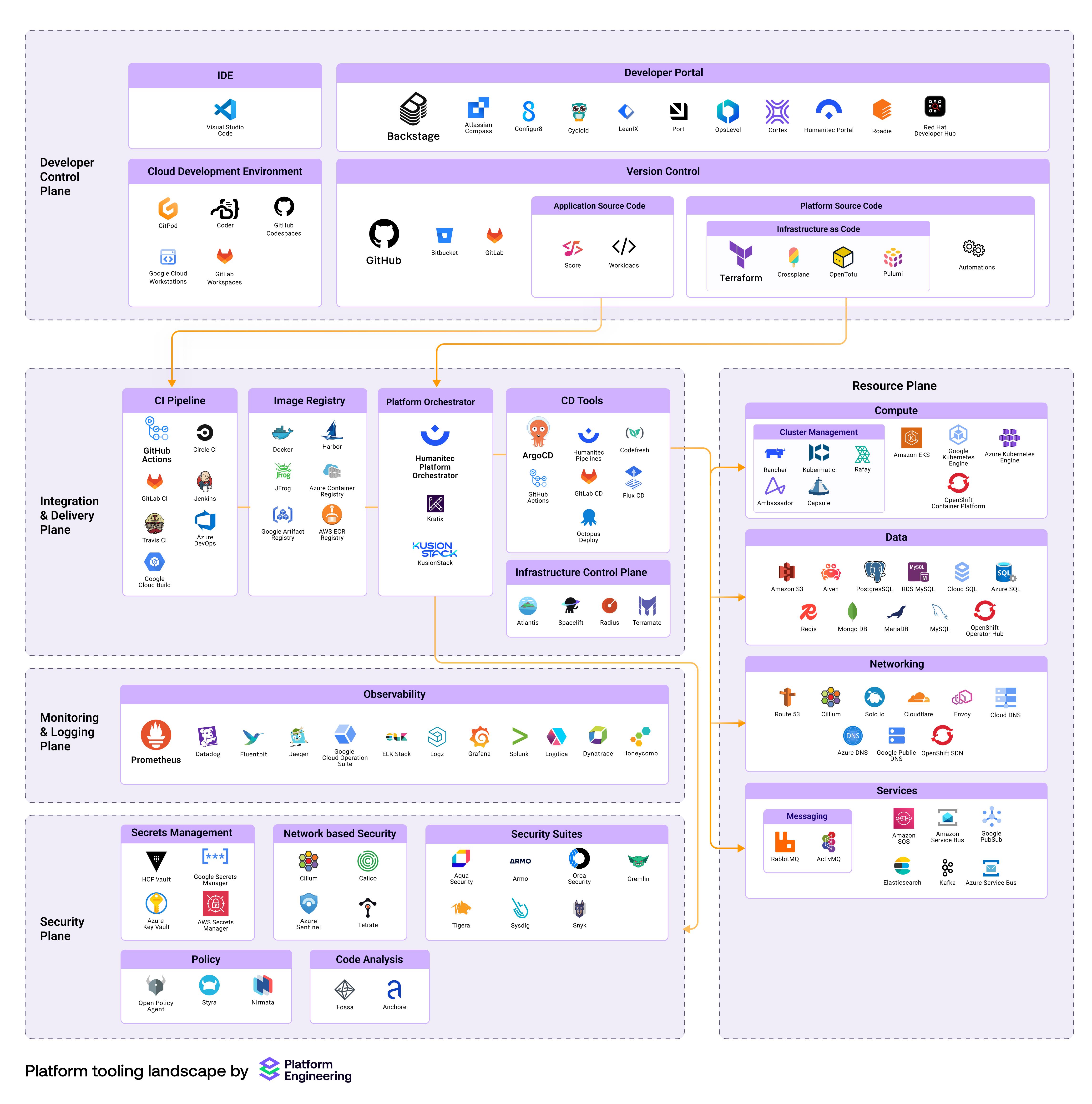Platform Tooling Landscape | 21 Best Platform Engineering Tools in 2025

If you’re a platform engineer or DevOps leader, you’ve likely felt overwhelmed by the sheer explosion of tools entering the market. The platform tooling landscape has grown exponentially in recent years, and figuring out the best stack for your team’s unique needs can feel like solving a puzzle with missing pieces.
Today, having the right platform engineering tools in place isn’t just a “nice-to-have”—it’s a necessity. But navigating the platform tooling landscape is just the first step—making these tools work together in harmony is where the magic happens.

A unified tooling strategy helps your team move faster, collaborate better, and stay ahead of challenges, whether you’re working on platform engineering solutions, DevOps tools, or other critical systems. Tools that empower your team to manage infrastructure effortlessly, accelerate development cycles, and innovate without friction are game-changers.
But here’s the catch: even the most promising emerging ecosystems often come with gaps.
Integration issues, scalability roadblocks, and clunky user experiences can slow your team down when you need them moving fast.
The Platform Engineering Tooling Landscape: Considerations
It’s an exciting time for platform engineering featuring tools and solutions that promise automation, developer productivity, and operational stability. But here’s the reality—assembling a cohesive tech stack is harder than it looks.
Why? Because:
- Integration Gaps: Tools often operate in silos, creating friction when trying to integrate them into a unified workflow.
- Scalability Issues: Some tools perform well in SMB environments but struggle at the enterprise level.
- User Experience: Developers want intuitive and easy-to-use tools that fit into their daily workflows, yet many solutions prioritize functionality over usability.
To build and drive adoption for a new platform, teams need tools that do more than function—they need solutions that unify workflows, promote collaboration, and scale with organizational growth.
Start by assessing where your team stands today. Use our DevX Starter Guide to identify first opportunities for improvement.
21 Best Platform Engineering Tools
The right tools can make or break a platform engineering strategy. Whether you’re scaling a startup or managing the complexities of an enterprise, these tools stand out for their ability to help platform teams design and implement scalable developer experiences.
Infrastructure Management Tools
Terraform: As the cornerstone of Infrastructure as Code (IaC), Terraform has been defining how teams manage infrastructure for over a decade. By defining your infrastructure as code, Terraform ensures everything stays consistent across environments, reducing the risk of errors. Whether you’re managing a single app or scaling a multi-cloud environment, Terraform provides the governance and reliability teams need to stay efficient.
Pulumi: Unlike traditional IaC tools, Pulumi allows developers to use familiar programming languages like Python, TypeScript, or Go to manage infrastructure. This flexibility makes it a favorite among development teams looking for tighter integration between application code and infrastructure.
Crossplane.io: Crossplane.io enables teams to define and manage cloud-native resources using Kubernetes-native APIs. With Crossplane, platform teams can build custom resource definitions (CRDs) to standardize infrastructure provisioning while empowering developers with self-service capabilities.
kro (Kubernetes Resource Orchestrator) by AWS: New kid on the block, kro, is bringing a fresh approach to managing Kubernetes resources by turning complex configurations into reusable building blocks. kro’s controller takes care of the heavy lifting, figuring out the right order of operations and dynamically managing everything behind the scenes.
Development Environment Tools
Okteto: Okteto delivers self-service Kubernetes development, test, and preview environments that mirror production. With a simple manifest, platform teams can offer single-click access to full environments with cloud resources, enabling new developers to be productive on day one.
With Okteto, we cut environment setup time by 90% and finally had time to focus on building features, not fixing environments.
Gitpod: A cloud-based IDE that automates development environments, Gitpod supports developers with prebuilt containers tailored to their projects. This is especially beneficial for developers and open-source contributors who want fast, disposable environments for quick tasks or contributions.
CI/CD Tools
Harness.io: Harness has gained in popularity with its focus on simplicity and intelligence. It combines powerful automation with AI/ML-driven insights to make building, testing, and deploying code faster and more reliable. With features like continuous delivery, feature flags, and cloud cost management, this is a great platform for teams looking to simplify DevOps workflows.
Jenkins: Jenkins has been around forever (in tech years), and there’s a reason for that: it’s powerful, flexible, and endlessly customizable. If you’re managing complex pipelines, Jenkins is a solid choice. The downside is that it does often require extensive customization.
Dagger.io: Dagger reimagines CI/CD by offering a portable and declarative approach to building pipelines. With Dagger, teams can define their workflows as code using a single, repeatable configuration, making it easy to run pipelines consistently across environments—from local machines to CI/CD systems.
GitHub Actions: Already living in GitHub? Actions allow teams to automate workflows directly within their repositories. It’s an excellent choice for smaller teams looking to accelerate releases.
GitLab: It wouldn’t be right to highlight CI/CD tools without mentioning this powerhouse. GitLab offers an all-in-one platform that integrates version control, CI/CD pipelines, and DevSecOps workflows. With its robust automation capabilities, GitLab empowers DevOps teams to manage the entire software development lifecycle in a single interface.
Monitoring and Observability Tools
Prometheus: In today’s world of Cloud Native development, everything moves fast. So, keeping an eye on your systems is critical. Prometheus, with its powerful query language and integration with tools like Grafana, ensures you’re never in the dark about your infrastructure’s health.
Honeycomb.io: Debugging distributed systems can feel like chasing a needle in a haystack. Honeycomb.io turns that haystack into a clear map of events, helping you visualize and troubleshoot issues in real time. Its event-driven approach allows teams to visualize and explore data in real time, pinpointing issues across complex architecture.
Datadog: Why settle for just metrics or logs when you can have it all? Datadog combines monitoring, logging, and tracing into one platform, offering complete visibility into your applications and infrastructure.
Security and Compliance Tools
Snyk: Security shouldn’t slow you down. Snyk integrates directly into your workflows, helping you find and fix vulnerabilities in code dependencies, containers, and infrastructure configurations without disrupting your momentum.
Wiz: Great, you’ve made it to the promised land of Cloud - now how do you ensure cloud environments are secure? Wiz provides an agentless approach to identifying vulnerabilities, misconfigurations, and risks across workloads, containers, and Kubernetes clusters. By prioritizing critical issues, Wiz helps teams stay ahead of security threats and maintain compliance with minimal disruption.
HashiCorp Vault: Secrets management can be tricky but will become a necessity for many platform engineering teams. This tool securely manages API keys, credentials, and other sensitive information, giving you peace of mind that your data is locked down tight.
ARMO: Keeping Kubernetes clusters secure doesn’t have to be a burden for DevOps teams. ARMO makes it easy by seamlessly integrating into your CI/CD workflows to detect vulnerabilities, enforce security policies, and maintain compliance—all without adding friction to your team’s processes.
Cost Management Tools
Kubecost: Managing Kubernetes costs can be a challenge, but Kubecost makes it simple by providing real-time insights into resource usage and spend across clusters. With Kubecost, teams can optimize workloads, identify inefficiencies, and take control of their cloud costs.
Okteto Resource Insights: Platform engineering teams use Okteto Insights to track environment usage trends, optimize infrastructure, and reduce unnecessary cloud costs by fine-tuning the resources allocated to your Kubernetes workloads. Ensuring resources are used efficiently can lead to uncovering opportunities to improve overall developer productivity and importantly find cost gains for organizations.
StormForge: StormForge simplifies the process of managing cloud resources with machine learning-powered optimization. By analyzing workload patterns, it identifies opportunities to reduce waste and improve performance, helping teams strike the perfect balance between cost and efficiency.
Closing the Gaps: Building a Unified Tooling Strategy
The tools we’ve explored each represent a few key parts of the platform tooling landscape, but the real challenge lies in creating a cohesive ecosystem. A unified platform tooling strategy isn’t just about selecting the best individual tools—it’s about ensuring they work seamlessly together to support your team’s goals. Here are a few considerations for platform teams:
- Meet developers where they are: Choose solutions, including DevOps tooling, that fit naturally into your workflows so your team spends less time troubleshooting and more time building.
- Automation Is Your Best Friend: Automate repetitive tasks wherever possible to free up your team’s time for high-impact work. The less manual intervention needed, the smoother your processes will run.
- Think Long-Term: The platform tooling landscape will continue to grow and evolve, so choose solutions that can scale effortlessly with your team’s growth and future needs.
- Focus on Developer Experience: The best tools are ones your team will actually use. Tools should make developers’ lives easier, so prioritize options that simplify workflows and free up time for innovation.
A well planned approach doesn’t just smooth out the bumps in your process—it gives your team the confidence to tackle big challenges and deliver great results.
Ready to take the first step? We’ve put together a guide to start mapping your current platform landscape and DevOps tools, and pinpoint areas for improvement and investment.
Get your Development Experience Starter Guide and start measuring impact.
